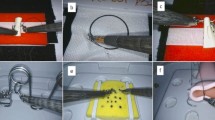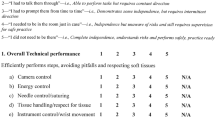Abstract
A robotics practice curriculum was developed utilizing dry lab skills and testing parameters based upon the objective structured assessment of surgical tasks (OSATS) to determine its effectiveness in training novice surgeons. We recruited 20 medical students who were oriented to the DaVinci S console and instrumentation. They were pre-tested with four dry lab skills including manipulation, transection, suturing and knot tying. A control group was instructed to practice once weekly to attain proficiency and the intervention group was provided specific instructions regarding practice goals. Each subject was post-tested after a 6-week time. There were 17 students who completed the post-testing. All participants showed significant improvement in pre-test and post-test scores for manipulation (6.6–11.2, p < 0.0005), transection (3.5–6.9, p < 0.0005), knot tying (0.4–1.7, p = 0.003), and suturing (2.0–3.5, p = 0.001). There was no significant difference in pre-test and post-test scores between the control and intervention groups in manipulation, transection, knot tying, and suturing (p = 0.700, 0.782, 0.682, 0.605, respectively). Our study shows that novice surgeons such as medical students can improve dry lab robotics skills with instruction and practice.







Similar content being viewed by others
References
Liu H, Lu D, Wang L, Shi G, Song H, Clarke J (2012) Robotic surgery for benign gynaecological disease. Cochrane Database Syst Rev 2:CD008978
Lu D, Liu Z, Shi G, Liu D, Zhou X (2012) Robotic assisted surgery for gynaecological cancer. Cochrane Database Syst Rev 1:CD008640
Boggess JF, Gehrig PA, Cantrell L, Shafer A, Mendivil A, Rossi E et al (2009) Perioperative outcomes of robotically assisted hysterectomy for benign cases with complex pathology. Obstet Gynecol 114(3):585–593
Lowe MP, Johnson PR, Kamelle SA, Kumar S, Chamberlain DH, Tillmanns TD (2009) A multiinstitutional experience with robotic-assisted hysterectomy with staging for endometrial cancer. Obstet Gynecol 114(2 Pt 1):236–243
Siddiqui N, Geller E, Visco AG (2012) Symptomatic and anatomic 1-year outcomes after robotic and abdominal sacrocolpopexy. AJOG 206(5):435e1–435e5
Maeso S, Reza M, Mayol J, Blaxco J, Guerra M, Andradas E (2010) Efficacy of the DaVinci surgical system in abdominal surgery compared with that of laparoscopy: a meta-analysis. Annals of Surg 252(2):254–262
Patel V, Thaly R, Shah K (2007) Robotic radical prostatectomy: outcomes of 500 cases. BJU Int 99(5):1109–1112
Garga A, Raghav C, Sayed S, Katna R, Komorowski (2012) A Robotic surgery in head and neck cancer: a review. J Thor CV surg 143(2):383–389
Antoniou G, Riga C, Mayer E, Cheshire N, Bicknell C (2011) Clinical applications of robotic technology in vascular and endovascular surgery. J Vasc Surg 53(2):493–499
Lee JY, Mucksavage P, Sundaram CP, McDougall EM (2011) Best practices for robotic surgery training and credentialing. J Urol 185(4):1191–1197
Zorn KC, Gautam G, Shalhav AL, Clayman RV, Ahlering TE, Albala DM et al (2009) Training, credentialing, proctoring and medicolegal risks of robotic urological surgery: recommendations of the society of urologic robotic surgeons. J Urol 182(3):1
Moles JJ, Connelly PE, Sarti EE, Baredes S (2009) Establishing a training program for residents in robotic surgery. Laryngoscope. 119(10):1927–1931
Geller EJ, Schuler KM, Boggess JF (2011) Robotic surgical training program in gynecology: how to train residents and fellows. J Minim Invasive Gynecol 18(2):224–229
Judkins TN, Oleynikov D, Stergiou N (2009) Objective evaluation of expert and novice performance during robotic surgical training tasks. Surg Endosc 23(3):590–597
Martin JA, Regehr G, Reznick R, MacRae H, Murnaghan J, Hutchison C, Brown M (1997) Objective structured assessment of technical skill (OSATS) for surgical residents. Br J Surg 84:273–278
Dulan G, Rege RV, Hogg DC, Gilberg-Fisher KM, Arain NA, Tesfay ST, Scott DJ (2012) Developing a comprehensive, proficiency-based training program for robotic surgery. Surgery 152:477–488
Glaser A, Hall C, Uribe J, Fried M (2005) The effects of previously acquired skills on sinus surgery simulator performance. Otolaryng 133(4):525–530
Tarr M, Mueller E, Rivard C, Summers S, Kenton K. Robotic objective structured assessment of technical skills (ROSATS): a randomized multicenter dry lab training pilot study. (in print)
Tarr M, Mueller E, Polcari A, Summers S, Kenton K (2011) Development of a robotic surgical training curriculum for gynecology and urology residents: robotic objective structured assessment of technical skills (ROSATS). Neuro Urodyn 30(2):249–250
Murphy D, Sundaram C (2013) Comparative assessment of three standardized robotic surgery training methods. BJUI 112(6):713–714
Conflict of interest
The authors have no conflicts to report in regards to this study. Dr. Megan Tarr is a member of the Robotic Training Network Curriculum design committee but this offers no conflicts in regards to this study All procedures were in accordance with the ethical standards of the responsible committee on human experimentation (institutional and national) with the Helsinki Declaration of 1975, as revised in 2000. Informed consent was obtained from all participants prior to being included in this study.
Author information
Authors and Affiliations
Corresponding author
Appendices
Appendix A: Dry lab skill practice instructions: self-directed curriculum group
Practice the surgical skills learned in orientation. You will have 6 weeks to work on these skills. You may familiarize yourself with the robot and individualize your practice sessions to improve your basic surgical techniques.
Practice the following skills as demonstrated by the instructional video and orientation demonstrations.
Skill 1: Manipulation
Skill 2: Transection
Skill 3: Knot Tying
Skill 4: Suturing
Appendix B: Dry lab skills practice instructions for intervention group

Appendix C

Rights and permissions
About this article
Cite this article
Summers, S., Anderson, J., Petzel, A. et al. Development and testing of a robotic surgical training curriculum for novice surgeons. J Robotic Surg 9, 27–35 (2015). https://doi.org/10.1007/s11701-014-0484-x
Received:
Accepted:
Published:
Issue Date:
DOI: https://doi.org/10.1007/s11701-014-0484-x




